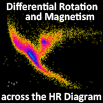Speaker
Gibor Basri
(Astronomy Department, Univ. of California, Berkeley)
Description
The Kepler Mission has opened a whole new volume of parameter space in the realm of
stellar photometry. It combines unprecedented precision with unprecedented long and
complete time coverage, for well over 100,000 stars throughout the HR diagram. In
particular it is very sensitive to starspots, with complete phase coverage over many
rotation periods. This affords us the opportunity to learn new basic information
about the relation between stellar parameters and magnetic activity. We can much
learn about the spatial distribution and temporal behavior of starspots under many
stellar conditions. Because starspots occur at a range of latitudes, there is also
the potential to track differential rotation. I discuss some of the obstacles that
must be overcome to realize this potential, including the difficulty of learning the
stellar inclination, the actual latitude of different starspots (or more accurately,
starspot distributions), and the confusion between spot size evolution and
redistribution of spots on the stellar surface due to differential rotation. It turns
out that even learning the rotation period(s) of a star is not trivial. I discuss
some of the latest methods for dealing with these issues (which thus far have
prevented firm conclusions on a large sample of stars), and apply some of them to
beginning to answer the question: what fraction of solar-type Kepler targets exhibit
measurable differential rotation.
Primary author
Gibor Basri
(Astronomy Department, Univ. of California, Berkeley)

